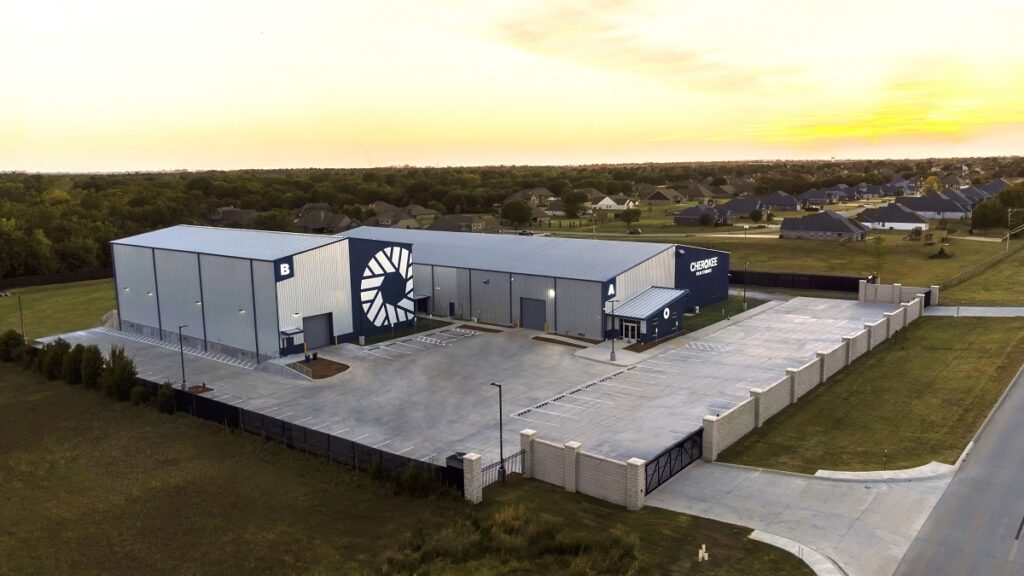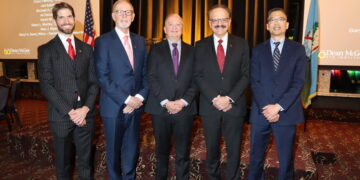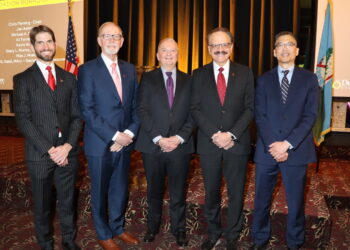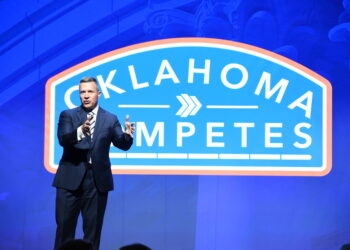OKLAHOMA CITY (OBV) – Lt. Gov. Matt Pinnell and state leaders participated in a lengthy panel discussion on Tuesday, exploring the rise of the state’s entertainment industry and how Oklahoma can become a top destination for major movie and television productions.
The panel discussion, titled “Cultural Impact of Oklahoma’s Entertainment Industry,” was held at the Oklahoma Contemporary Arts Center. Oklahoma Film + Music Office Director Jeanette Stanton, Oklahoma City Community College President Dr. Mautra Staley Jones and Oklahoma Tourism and Recreation Executive Director Shelley Zumwalt participated in the panel alongside Pinnell.
The panel was hosted by Rachel Cannon, a leading force in Oklahoma’s film and television industry. Cannon got her start in entertainment as an actress, appearing in several hit television shows, including Big Bang Theory, Two and a Half Men and Mad Men. She went on to a six-year stint as a series regular on the popular ABC comedy, Fresh Off the Boat, playing recurring character Deidre.
Pinnell spoke with Oklahoma Business Voice before the panel discussion kicked off. He stressed the importance of having dialogue about the Oklahoma film and television industry’s impact, but said action is needed to fully realize the industry’s vast potential and attract large film and television productions.
“We have to get the industry together; they have to be singing off the same song sheet down at the State Capitol,” Pinnell said. “And I think in the next legislative session, they will be, when it comes to taking a look at the rebate and helping entrepreneurs from an infrastructure perspective. Our film industry has grown by over 700 percent over the last decade, but soundstage and infrastructure has only grown by 15 percent.”
Film and television production has grown significantly in Oklahoma in recent years:
- The summer blockbuster Twisters was shot in Oklahoma.
- The first season of the Paramount Plus show Tulsa King was filmed in Tulsa, Oklahoma City and other in-state areas.
- The popular FX television show Reservation Dogs is shot in the Sooner State, specifically in Okmulgee.
- The critically-acclaimed feature film Killers of the Flower Moon, directed by legendary filmmaker Martin Scorsese and starring Leonardo DiCaprio, Robert De Niro and Brendan Fraser, filmed in several locations across Oklahoma, including Bartlesville, Fairfax, Osage County, Pawhuska and Tulsa.
- Current theatrical release Reagan was filmed almost entirely in Guthrie.
“Not only do we have films that are in theaters, but we have films that are crushing the box office that were filmed in Oklahoma,” Cannon said.
The Filmed in Oklahoma Act of 2021 gives a maximum of $30 million in cash rebates to film and television productions shot in Oklahoma each fiscal year, which is from July 1 to June 30, for 10 years. A production must spend over $50,000 in the state to qualify for the rebate.
“The industry would like to raise that [rebate incentive] between $50-80 million; frankly, many would like to take it higher than that,” Pinnell said.
The rebate incentive has to be raised to lock in production companies that are interested in filming in Oklahoma, Pinnell said.
“We turned away about $80 million worth of business last year, and that’s one of the reasons the industry was looking to get an $80-million rebate program,” Pinnell said. “We’ll see what the legislature is open to. There’s going to be asking for more money for state agencies. What I can tell any legislator though is the return on the investment that they’re going to get [by increasing the rebate incentive]. The return on the investment right now is very, very good when it comes to this incentive.”
Over $118 million was spent in Oklahoma last year on film production, as well as around $58 million in payroll to people working in those productions, according to Pinnell.
“It’s real numbers. It’s thousands and thousands of jobs, and it’s helping diversify our economy – I think that’s a really key point,” Pinnell said. “The whole goal for any Republican, Democrat or Independent, in the state of Oklahoma, should be further diversifying our economy. A 700 percent increase in activity is an industry on the rise, and it’s an industry that’s helping diversify our economy and offering a lot of jobs to kids coming out of high school, CareerTech and college – and that’s good for the state.”

Previous increases to the cash rebate spurred the growth of Oklahoma’s film and television industry, Pinnell said.
“It started off with a $4-million rebate, then went to $8 million. For for us to have a $30 million cash rebate program, it does make us very competitive nationally,” Pinnell said.
The lieutenant governor said that while Oklahoma’s 20 percent base rebate is strong, it’s not high enough to compete with incentives offered in Georgia, which grants a 30 percent income tax credit to film and TV productions, New Mexico, which has a 25-40 percent tax credit, and Texas, which provides up to 22.5 percent cash grants on qualified expenditures.
Oklahoma’s smaller rebate incentive was one of the main reasons Paramount Studios moved Tulsa King to Georgia for the show’s second season production, Stanton said.
The smaller incentive also caused Oklahoma to lose out on another major Paramount production.
Paramount approached the Oklahoma Film + Music Office years ago about filming both Tulsa King and Lawmen: Bass Reeves, a show based on the legendary deputy U.S. marshal, in Oklahoma.
“They said, ‘We’d like to do both here,’ and we said, ‘We only have money for one.’ They said, ‘Well, Tulsa King’s ready to go, so let’s go,'” Stanton said.
Twisters was a hot topic of conversation during the panel discussion, with the panel speaking at length on the film’s presence in Oklahoma and impact on the workforce.
The film’s producers were impressed by the enthusiastic welcoming that Stanton and Pinnell gave the production, according to Cannon.
“They have just been blown away by how accessible our state leadership is,” she said.
Stanton worked closely with Universal Studios to bring the production to Oklahoma. Being honest and staying in close communication with studio leadership was key to bringing Twisters to Oklahoma.
“It is kind of like putting a puzzle together, and I had a lot of great people helping along the way. I made some really great friends along the way too,” Stanton said. “It was definitely pretty stressful to be working on December 23rd and sending emails and trying to put stuff together, but it was really, really worth it and I definitely learned a lot.”
Twisters has grossed $369,623,050 worldwide, as of Sept. 25.
Like its predecessor Twister, Twisters was filmed extensively in Oklahoma. The Oklahoma Film + Music Office (OF+MO), a business development unit of the Oklahoma Department of Commerce, partnered with the Universal Filmed Entertainment Group (UFEG) for the Universal Below-the-Line Traineeship on Twisters, which was released on July 19 by Universal Pictures and Amblin Entertainment and proved to be a massive success at the summer box office.
The traineeship program provided increased access and opportunities within all film production areas and helped grow the state’s workforce.
Numerous Oklahomans who are new to the film industry, including individuals from historically underrepresented backgrounds, participated in the production as trainees. They received on-set experience and mentorship in a wide range of production areas, including VFX, production accounting and sustainability departments, art department, construction, costume and production office, in partnership with IATSE Local 484, according to Oklahoma Department of Commerce officials.
The Twisters production relied upon the state’s film programs and film incentives administered by the newly launched Oklahoma City Film & Creative Industries Office (OKCFCIO).
Principal photography on Twisters began on May 8, 2023, and lasted 60 days. The production involved several communities, including including El Reno, Chickasha, Midwest City, Spencer, Kingfisher, Calumet, Hinton, Fairview, Okarche, Kremlin, Burbank and Pawhuska.
The first film in the franchise, Twister, was filmed across Oklahoma in 1995 and went on to earn nearly $500 million worldwide in the summer of 1996. Its legacy in Oklahoma includes a Twister Museum in Wakita, Okla., which features film props, artifacts and much more.

Much of Twisters was shot at Prairie Surf Studios in Oklahoma City.
Prairie Surf Studios, which is part of Prairie Surf Media, is a 1.3 million square-foot facility that has five soundstages – two 32,000 feet, one 25,000 feet and the remaining two 24,500 feet – each retrofitted to support major film and television show productions.
The studio is the former location of the Myriad Convention Center, which opened in 1999 and later became known as the Cox Convention Center. The convention center was leased to Prairie Surf Media and converted into the studio after the Oklahoma City Convention Center opened, thanks to the city’s MAPS 3 funding initiative. Over 100,000 square feet of new space was added during the conversion.
Oklahoma native and Hollywood screenwriter Matt Payne cofounded Prairie Surf with Cannon. Payne achieved success as a writer on many TV shows, including Vegas, Memphis Beat, The Defenders and Without a Trace. He returned to Oklahoma in 2015 and has since played a prominent role in the state’s film community, producing documentaries for Griffin Communications and the OETA Foundation and teaching film business and screenwriting at Oklahoma City University.
Cannon is no longer part of Prairie Surf but remains active as an Oklahoma film and television industry ambassador.
The long-term goal for Prairie Surf was to move into the entertainment side of movie and television production. Prairie Surf Media produced multiple documentaries the past couple of years, including The Jewel, which looks at the history of Northeast Oklahoma City’s beloved Jewel Theatre and the effort to restore it from a state of disrepair. The company also produced a documentary on legendary Oklahoma educator and civil rights activist Clara Luper.
The panel discussed Prairie Surf’s future. The city still owns the physical space where Prairie Surf is located, and the media company’s time there will conclude at the end of this year.
“We were able to use that building for four years to be able to prove the concept, that we can bring in and service bigger budget productions here. It was never supposed to be a forever home. It was supposed to be, ‘Let’s prove the concept to show that it works here,'” Cannon said. “Just because the building is going away, it has not slowed down the applications that are coming in [from productions]. They may not be shooting on sound stages, but we are still getting incredible momentum. It sets the stage for somebody who does have a business plan to step in and do it quickly because we de-risked it for them.”
Pinnell said he hopes that Prairie Surf will find another location and endure.
“I have high hopes for Prairie Surf moving forward, that they will find a new home. I’m very confident that Oklahoma City will continue to build out its [studio space] infrastructure,” Pinnell said.
Pinnell said he and his colleagues are constantly having conversations with studios about bringing productions to Oklahoma.
“When I say constantly, I mean on a monthly if not weekly basis with studios and streaming services. Netflix is going to spend $17 billion alone in 2024. Over $247 billion is going to be spent [by studios and streaming services] on content. We want a lot of that content being filmed in Oklahoma,” he said.
Oklahoma is in an advantageous spot because it remains a mostly unknown quantity within the entertainment industry, Zumwalt said.
“It’s not that there’s a bad perception, I think we just have a lack of a perception. And that’s actually, from a marketing standpoint, the best place to be,” she said.

Oklahoma City Community College is also an invaluable asset to Oklahoma’s film and television industry. The school’s Gray Frederickson Digital Cinema Department provides students with the training they will need to get a job in film and television productions.
The program is named after the late Gray Frederickson, an Oklahoma City native and Academy Award-winning producer of several iconic films, including The Godfather Part II, Apocalypse Now and The Outsiders.
“We’re blessed to have Gray’s legacy and the visionary work that he was doing decades ago. He understood and saw the need to drive film and make Oklahoma a desirable destination for big productions,” Jones said. “We’ve been doing this work and engaging in this work for decades, and we’re so proud that his legacy lives on.”
OCCC has proven to be a boon for the state’s entertainment industry, equipping students with the skills needed to fill a wide range of on-set positions in film and television productions.
Jones attributes OCCC’s success in providing talent to the state’s entertainment industry workforce to the college’s “remarkable faculty, staff and students.”
“We are very careful and strategic and intentional about not only our partnerships, but understanding what industry needs. We’re able to be agile and nimble to meet industry’s needs, and they’re ever-evolving. My heart is so full of pride and joy over all the work that we are doing, but it’s because we have incredible partners, because we have tremendous faculty and staff who have the knowledge and the skillset,” Jones said. “Everyone is really intentional in that training and leaning on their industry connections and contacts to bolster our program. And I would say that those are many of the factors as to why we have that recognition.”
In addition to its regular film curriculum, OCCC offered non-credit digital cinema production “intensive” courses this past summer, providing participants career-ready training in a workforce development-focused format.
The intensives, taught by film industry professionals, included Set Construction, Scenic Painting, Set Dressing and Grip & Electric. Non-credit micro-credentials for each course were awarded after successful course completion. The Grip & Electric course also includes certifications in scissor lift and condor operations.
MovieMaker, a resource for interviews, behind-the-scenes movies stories, movie recommendations, festival coverage and other film production-related information, ranked OCCC’s Gray Frederickson Department of Digital Cinema as one of the 30 best film schools in the U.S. and Canada in 2024.
OCCC is the most affordable community college in the state. School officials recently announced that the school is keeping its tuition rate flat for the seventh straight year. It will remain $135.29 per credit hour for in-state tuition and fees ($100.84 tuition, $34.45 mandatory fees).

The Cherokee Nation is also making major contributions to Oklahoma’s film industry. The tribe recently cut the ribbon on the second soundstage at Cherokee Film Studios.
The 10,000-square-foot soundstage has a 35-foot ceiling, full soundproofing to cinema standards, a modular truss system with chain hoists, a hair and makeup room, a multipurpose/flex space, restrooms, 14-foot bay doors for load-ins, and RV hookups for production trailers. Additional changes to the Owasso film campus include classroom space for the Cherokee Film Institute, a new lobby and waiting area for clients, a construction mill space equipped with a cyclonic air filtration system, production offices and conference rooms, wardrobe and storage spaces, an audio recording suite, a catering kitchen and an additional greenroom, according to Cherokee Nation officials.
The studio is located on more than four acres within the tribe’s reservation, less than 20 minutes from Tulsa International Airport. It has state-of-the-art extended reality (xR), virtual production LED volume studio crafted with industry-leading software and hardware technologies.
The campus also consists of 14,000 square feet of dedicated virtual production and practical studio space, edit suites, a control room, a pro-grade audio booth, crew and client lounges and hair and makeup facilities.
Pinnell, who was present at the ribbon cutting, lauded the Cherokee Nation’s ongoing effort to help grow the film and television industry. He described the Cherokee Film Studios expansion as one of the most exciting developments in the history of Oklahoma’s film industry.
State leaders are working with sovereign nations to grow the film and television industry in Oklahoma, according to Pinnell.
More studio infrastructure and tribal partnerships are essential to taking Oklahoma’s film and television industry to the next level, Pinnell said.
“The infrastructure has to go along with the incentives that the state is offering, and that will be a conversation that we will have with the legislature,” Pinnell said. “We have to stay competitive [with incentives], but it’s not just about the rebate. The differentiator for Oklahoma versus every other state is our sovereign nations and the fact that they are involved in production now. The Choctaw Nation, Cherokee Nation, Chickasaw Nation – that differentiates us from everybody else. The Cherokee Nation is offering a rebate and they can layer that rebate on top of our rebate. No other state is really doing that, and no other state has as powerful of a sovereign infrastructure as we do with our 39 sovereign nations.”
Oklahoma’s legislators now see the potential of the state’s entertainment industry and are interested in making it stronger, according to Stanton.
“Having those conversations now is really great because they want to know more. It’s a totally different landscape now,” Stanton said.
Oklahoma’s ability to attract major film and television productions, ultimately, comes down to dollars and cents, Stanton said.
“Obviously, an increase in the incentive would make a big difference because it keeps the workforce going. The model of the film industry is, unfortunately, very heavily based on money incentive; and that’s not just us, that’s over 40 states,” she said. “So, we have to be very competitive in this space. But ultimately, what we want to do is to make sure that the workforce is consistent. That’s the goal at the end of the day, you should be able to go from job to job to job, which makes it a full time job, 365 days a year.”

















